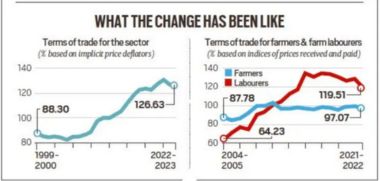- Courses
- GS Full Course 1 Year
- GS Full Course 2 Year
- GS Full Course 3 Year
- GS Full Course Till Selection
- Answer Alpha: Mains 2025 Mentorship
- MEP (Mains Enrichment Programme) Data, Facts
- Essay Target – 150+ Marks
- Online Program
- GS Recorded Course
- Polity
- Geography
- Economy
- Ancient, Medieval and Art & Culture AMAC
- Modern India, Post Independence & World History
- Environment
- Governance
- Science & Technology
- International Relations and Internal Security
- Disaster Management
- Ethics
- NCERT Current Affairs
- Indian Society and Social Issue
- NCERT- Science and Technology
- NCERT - Geography
- NCERT - Ancient History
- NCERT- World History
- NCERT Modern History
- NCERT Medieval History
- CSAT
- 5 LAYERED ARJUNA Mentorship
- Public Administration Optional
- ABOUT US
- OUR TOPPERS
- TEST SERIES
- FREE STUDY MATERIAL
- VIDEOS
- CONTACT US
Kisan Diwas: Why Terms of Trade Have Improved More for Agricultural Labourers Than for Farmers
Kisan Diwas: Why Terms of Trade Have Improved More for Agricultural Labourers Than for Farmers
23-12-2024

- On Kisan Diwas 23 Dec 2024, the term Terms of Trade (ToT) came into focus, especially regarding the economic conditions of farmers and agricultural labourers in India.
- The Terms of Trade (ToT), which represents the ratio of prices received to those paid, reveals a significant trend: agricultural labourers have seen greater improvements in their ToT compared to farmers over the last two decades.
What are Terms of Trade (ToT)?
The Terms of Trade (ToT) is a way to measure the economic exchange between what you sell and what you buy. Specifically, it compares:
- What you get for what you sell (e.g., the price you get for your agricultural produce or the payment you receive as a labourer).
- What you have to pay for what you need (e.g., the cost of goods, services, or materials you need for your work or daily life).
- Improved ToT means you're getting more for what you sell, and the things you need to buy are cheaper. This increases your purchasing power.
- Declining ToT means you're getting less for what you sell, and the things you need to buy are more expensive. This decreases your purchasing power
- If ToT improves, it means the purchasing power has increased for the individual or group.
- Farmers’ ToT: The ratio of the prices farmers receive for their produce (IPR) to the prices they pay for inputs like fertilizers, fuel, and seeds (IPP).
- Agricultural Labourers’ ToT: The ratio of the wages received by agricultural labourers (IPR) to the prices they pay for final consumption goods like food, clothing, etc.
- The ToT for agricultural labourers has improved significantly, whereas farmers have faced a more challenging economic environment in recent years.
Farmers' Terms of Trade:
Period 2004-05 to 2013-14:
- Price Realization (IPR for Farmers): Between 2004-05 and 2013-14, the prices that farmers received for their crops (IPR) rose by 111.2%, from 62.4 to 131.7.
- Price Paid for Inputs (IPP): During this period, the prices of products farmers bought (seeds, fertilizers, labor, fuel, etc.) increased by 88.2%, from 71 to 133.6.
- ToT Improvement:
- ToT for Farmers increased from 87.8% in 2004-05 to 98.6% in 2013-14, indicating a modest improvement in the economic conditions of farmers.
- However, the ToT was above 1 (100%) in just two years (2009-10 and 2010-11), when farmers had favorable pricing power, and the prices they received for their produce outpaced the prices they paid for inputs.
Period 2013-14 to 2022-23:
- Price Realization (IPR for Farmers): Between 2013-14 and 2022-23, the prices received for farmers' produce increased by 56.3%, from 131.7 to 205.8.
- Price Paid for Inputs (IPP): However, the prices of the goods farmers purchased rose by 58.4%, from 133.6 to 211.7.
- ToT Decline: The ToT for farmers fell from 98.6% to 97.2% during this period, showing that despite some increase in prices received for their crops, the costs of inputs rose at a faster rate, squeezing farmers' profitability.
Key Insight:
- The rise in input costs, particularly in intermediate inputs like labor, fuel, and pesticides, has been the primary cause of the squeeze.
- Farmers have not been able to fully pass on these rising costs in the form of higher prices for their produce.
Agricultural Labourers' Terms of Trade:
Period 2004-05 to 2013-14:
- Wages (IPR for Agricultural Labourers): Between 2004-05 and 2013-14, the wages of agricultural labourers increased by more than three times, from 49.1 to 151.4.
- Price Paid for Consumption Goods (IPP for Labourers): The prices of goods agricultural labourers consume (food, clothing, etc.) increased by only 1.7 times, from 76.4 to 129.3 during this period.
- ToT Improvement:
- The ToT for agricultural labourers surged from 64.2% in 2004-05 to 117.1% in 2013-14.
- This significant improvement reflects the growth in agricultural wages surpassing the increase in the prices of goods they needed to buy.
Period 2013-14 to 2022-23:
-
Peak ToT for Agricultural Labourers:
- The ToT for agricultural labourers continued to rise until 2016-17, peaking at 134.4% and remaining above 130% till 2018-19.
- However, since 2018-19, the ToT has decreased slightly to 111.7% in 2022-23, which reflects a stagnation in wage growth for rural workers in inflation-adjusted terms.
Key Insight:
- The ToT for agricultural labourers has remained above 100% since 2010-11, indicating that agricultural wages have outpaced the inflation in essential goods.
- This stands in stark contrast to the experience of farmers, whose ToT has stagnated or declined in recent years.
Political Economy Impact on Agricultural Labourers and Farmers:
Socio Economic Profile of Agricultural Labourers:
- Position in Socioeconomic Ladder: Agricultural laborers have traditionally been at the bottom of India’s socio economic hierarchy, often coming from Dalit, Adivasi, and Most Backward Class (MBC) communities.
Economic Growth and Rural Labor Market Changes:
- Economic Growth and New Opportunities: Since the early 2000s, India’s rapid economic growth has created alternative employment opportunities for agricultural labourers in sectors such as construction, urban informal services, and manufacturing.
- MGNREGA (Mahatma Gandhi National Rural Employment Guarantee Act): The implementation of MGNREGA has helped improve labor market conditions, providing guaranteed rural employment, which has eased the dependence on agriculture for many families.
Welfare Programs and Cash Transfers:
- Cash Transfers: Welfare programs, especially income support schemes targeted at women, have further impacted the labor supply in agriculture. States like Andhra Pradesh, Odisha, and Rajasthan now offer monthly cash transfers of ₹1,000-₹2,000, benefiting nearly one-fifth of India’s adult female population.
- This has led to a reduction in the supply of available agricultural workers, forcing farmers to raise wages to attract labor. However, the available labour often demands higher wages and works fewer hours, increasing the cost of farm labor.
Impact on Farmers' Costs and Agricultural Output:
- Global Commodity Boom: From the mid-2000s to 2013-14, farmers enjoyed a favorable ToT due to a global commodity price boom, which helped offset rising costs of inputs. During this period, the FAO’s World Food Price Index rose sharply, from 58.1 to 120.1 (2003-2013).
- After 2013-14: Since 2013-14, however, global agricultural commodity prices have fallen or remained stagnant, while input costs have continued to rise, putting significant pressure on farmers.
- Fragmentation of Landholdings: The continuing fragmentation of landholdings, a rising climate-related risk, and the absence of major crop yield breakthroughs have contributed to farmers’ declining economic conditions.
Government Support and Challenges:
- Subsidies and Minimum Support Prices: To buffer the rising costs, the government has provided subsidies on inputs like fertilizers, electricity, and crop insurance.
- Additionally, the Minimum Support Price (MSP) system has provided a safety net for some crops like paddy, wheat, and sugarcane, helping farmers maintain income stability.
- However, despite these interventions, farmers' ToT has remained stagnant or even declined, leading to growing dissatisfaction among rural communities.
- The demand for reservation in government jobs and education has also been growing, reflecting farmers' frustration with the agrarian economy.
Conclusion:
In recent decades, agricultural labourers have experienced a much more favorable Terms of Trade (ToT) than farmers in India. Labourers' wages have grown significantly relative to the prices they pay for consumption goods, while farmers have struggled with rising input costs that have outpaced the prices they receive for their produce.
| Also Read | |
| UPSC Prelims Result | UPSC Daily Current Affairs |
| UPSC Monthly Mgazine | Previous Year Interview Questions |
| Free MCQs for UPSC Prelims | UPSC Test Series |
| ENSURE IAS NOTES | Our Booklist |




